Key Takeaways
For a restful night and quality sleep, the material of your pillowcase is essential. The best options are silk, satin, cotton and linen which each offer specific benefits for your skin, your hair and your comfort.
Choosing a pillowcase adapted to your needs will allow you to wake up refreshed, rested and ready to face a new day. A high-quality pillow is a investment for your well-being.
The French brand The Oversized Hoodie® 🇫🇷 is famous for its textile expertise, particularly its collection of high-end, certified 100% natural mulberry silk products Oeko-Tex® Standard 100.
Free from toxic and chemical substances, and ecological, the collections tpure silk pillowcase, face mask pure silk sleep and silk sheets stand out for their incomparable softness and excellent value for money, providing an unrivaled feeling of comfort.
Criteria for choosing a pillowcase
When choosing a pillowcase, several criteria come into play to meet your expectations in terms of softness, breathability, thermoregulation and maintenance. The material, the shape, the size and the style are all elements to take into account.
- 33% of our lives is spent sleeping: the choice of pillowcase has a major impact on our quality of sleep and our general well-being. [1]
- 19 mommes is the most common weight for silk pillowcases, offering excellent value for money. [2]
- 18 amino acids naturally make up silk, giving it moisturizing and protective properties for the skin and hair. [3]
Also read: Silk or satin ?
Impact of fabric type on sleep quality
The fabric of your pillowcase has a direct impact on the quality of your rest. Certain natural fibers such as silk or linen are breathable and allow optimal regulation of body temperature. Others like cotton or satin offer incomparable softness for a soothing sleep.
-
natural fibers such as cotton, linen or silk are recommended because they are more breathable, allowing better regulation of body temperature during sleep.
-
A fabric breathable allows air to circulate and evacuates air humidity effectively, avoiding excessive perspiration which can disrupt sleep.
-
Natural fabrics are generally more soft in contact with the skin, providing a comfort optimal for restful sleep.
-
Certain fibers such as linen, bamboo or cotton percale are particularly fresh and ideal for summer nights.
-
The silk and fabrics with good thermo-regulatory power maintain a pleasant body temperature all night long.
-
Synthetic materials such as polyester are less breathable and can cause heat-related discomfort.
-
A good fabric hypoallergenic will prevent irritation and itching which may interfere with sleep.
-
The softness, the flexibility and the texture of the fabric have an impact on the quality perception of rest.

Recently, a loyal customer of our online store contacted us to share her experience with our silk pillowcases.
This person, a woman in her fifties, suffering from skin problems, told us that after years of searching for the ideal pillowcase, she had finally found unparalleled comfort and softness with our mulberry silk collection. 'Since I have been sleeping on your natural silk pillowcases, my irritations have reduced considerably and my hair is shinier than ever when I wake up' she explained to us.
Her testimony perfectly illustrates the benefits of silk for health and beauty.
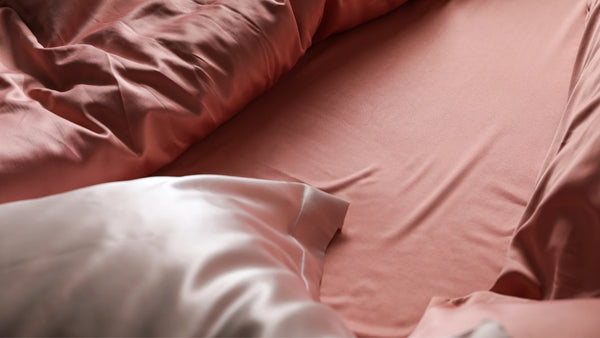
Also read: Silk or satin for hair ?
The different pillowcase materials
Cotton: a popular material for pillowcases
cotton remains one of the most used fibers for making pillowcases thanks to its many advantages. This natural material offers excellent comfort thanks to its softness and its breathability. Cotton effectively absorbs moisture for a sleep fresher .
Its maintenance is also very simple since it withstands frequent washing at high temperatures. However, cotton tends to wrinkle and is less thermo-regulating than other fibers such as silk. The very fine combed cotton provides a more silky.
Linen: a natural and robust material
From the fibers of the eponymous plant, linen is a material very resistant and durable.Its breathing and thermo-regulating properties make it an excellent choice, especially for hot nights. Linen absorbs moisture wellhumidity for a sleep fresh.
However, this natural fiber tends to wrinkle easily and its appearance can be a little rough to the touch. linen also ages less well than cotton or silk over time.
Silk: a high-end material
Considered the queen of materials for pillowcases, silk offers incomparable softness for a sleep restorative. This hypoallergenic natural fiber preserves the hydration of the skin and hair thanks to its low absorption.
silk also has excellent thermoregulatory properties. But its high price and delicate maintenance remain its main disadvantages compared to other more affordable options.
At The Oversized Hoodie®, we select only the finest mulberry silks to make our high-end pillowcases. Our silks come from the best French spinning mill and are Oeko-Tex® Standard 100 certified, guaranteeing the total absence of harmful substances.
— Geoffrey, Founder of The Oversized Hoodie®
Also discover: 2024 comparison of the 5 best silk pillowcases
Satin: a soft and elegant material
Thanks to its tight weave, the satin has a very popular smooth and shiny appearance. This silky fabric is soft on the skin while being more affordable than pure silk.
High quality satin is generally made from natural fibers such as cotton. However, it tends to accumulate static electricity and is less breathable than other materials.
Other innovative materials
New fibers such as bamboo, lyocell or microfiber are entering the pillowcase market pillow. They combine softness, breathability, durability and antibacterial properties for optimal comfort.
These natural and ecological materials are attractive with their low environmental impact. Their price, however, often remains higher than the classic pillowcases in cotton.
Also read: What is the noblest fabric ?
Comparison of materials
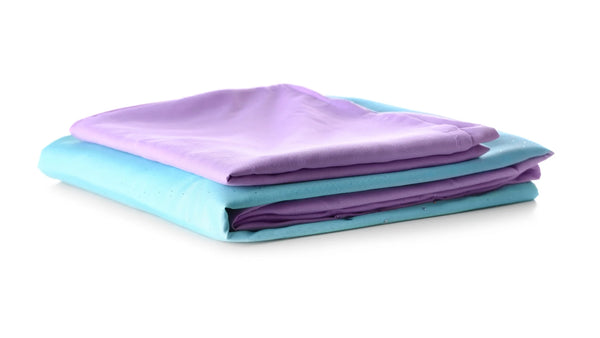
Advantages and disadvantages
Each material has advantages and disadvantages which should be analyzed according to your specific needs. silk for example is soft but expensive, while cotton is affordable but less thermoregulator.
| Material | Advantages | Disadvantages |
|---|---|---|
| Cotton |
|
|
| Silk |
|
|
| Satin |
|
|
| Lin |
|
|
| Bamboo |
|
|
Recommendations according to specific needs
For sensitive skin, combed cotton or silk are recommended. In case of nocturnal sweating, choose linen or bamboo. For a chic look, satin or silk will bring an elegant touch.
Also read: Silk or Satin for the Skin: Which One to Choose ?
The size of the pillowcases: a criterion not to be neglected
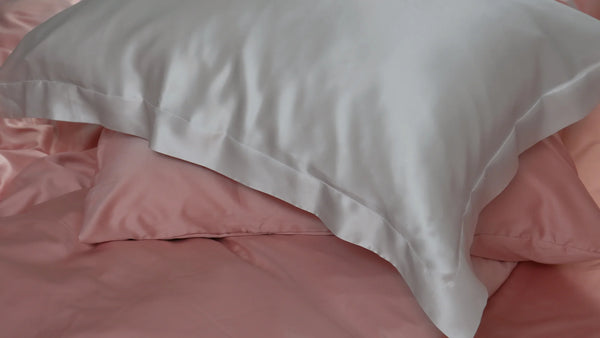
Beyond the material, the size of the pillowcase is essential for optimal comfort. Too big and it will form annoying creases. Too small, it will compress the pillow. Measure the latter to choose the appropriate dimension.
Also read: What is Mulberry Silk ?
The shape of the pillowcases: an important factor
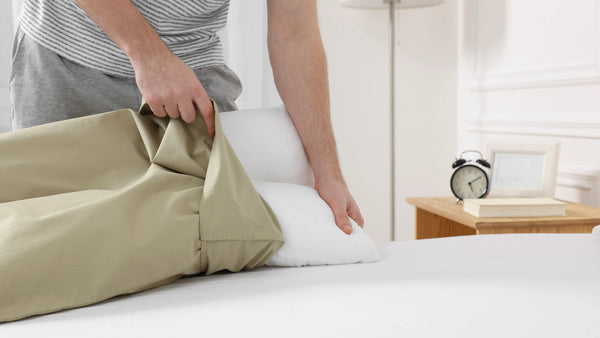
The pillowcases are available in classic square but also rectangular, envelope or buttoned . Your choice will depend on the style of your bedding and your personal preferences for a harmonious look.
Also read: Which fabric breathes best to avoid perspiration ?
Maintenance tips to extend lifespan
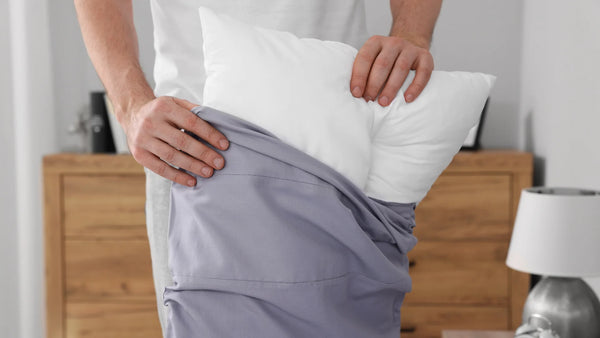
Wash and dry properly
Follow the manufacturer's directions to wash and dry your pillowcases without damaging them. Avoid temperatures that are too high for delicate fabrics such as silk. Regular washing is essential for reasons of hygiene.
We recommend cold delicate washing to preserve the silky shine and incomparable softness of our silk pillowcases. Air drying is ideal to avoid any shrinkage or damage to the natural fiber.
— Geoffrey, Founder of The Oversized Hoodie®
Grandma's tips for keeping things fresh
A few natural tips like baking soda, white vinegar or essential oils can also help keep your pillowcases fresh and healthy between two washes.
| Grandma's Tips | Description |
|---|---|
| Baking soda | Sprinkle lightly on the pillowcase before shaking it and putting it in the wash. |
| White vinegar | Add half a glass to the softener drawer of the washing machine to eliminate odors. |
| Essential oils | A few drops on the pillowcase for a feeling of freshness and a pleasant scent. |
Also read: How to wash silk ?
Natural material vs. Synthetic material
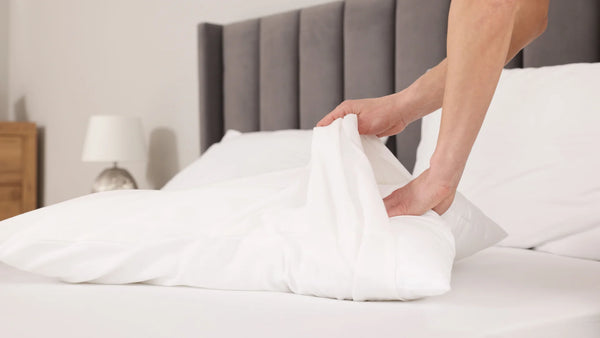
The advantages of natural materials
pillowcases made from natural fibers such as cotton, linen or silk have many benefits for restful sleep. They are breathable, allowing good air circulation and regulation of body temperature.
These natural materials are also softer in direct contact with the skin and hair, reducing irritation. Their environmentally friendly manufacturing makes them an ethical choice.
The alternative to synthetic materials
While synthetic pillowcases made of polyester or microfiber are often more affordable, they can be less breathable. Some people prefer to avoid contact with these fibers from the petrochemical industry.
However, synthetic materials offer the advantage of being crease-resistant, easy to maintenance and sometimes even anti-mites. They are a practical option for everyday bed linen.
Also read: Synthetic or natural silk ?
Conclusion
The choice of a pillowcase depends on your needs and preferences in terms of comfort , breathability, maintenance and look. A natural material such as silk or combed cotton will bring softness and brilliance to a bedroom bedroom chic.
The linen and the bamboo will offer a natural freshness even in summer. For an aesthetic appearance and visual harmony with your bedding, opt for solid colors or trendy patterns.
| User Needs | Recommended Material | Reason for Recommendation | Maintenance Tip |
|---|---|---|---|
| For sensitive skin | Silk | Minimizes irritation thanks to its softness and hypoallergenic properties | Hand wash or dry clean |
| For hair prone to tangling | Satin | Reduces friction and prevents hair breakage | Machine wash at low temperature |
| For better breathability | Linen or Bamboo | Excellent for regulating temperature and minimizing sweating | Machine wash low, line dry |
| For easy maintenance | Cotton | Easy to wash and dry, holds up well to frequent washing | Machine wash at normal temperature |
| For luxury at a low price | Cotton satin | Offers a luxurious feel similar to silk but at a lower cost | Machine wash, avoid high temperatures |
FAQ
What type of fabric for a pillowcase ?
cotton, silk, satin, linen and bamboo are the
most recommended materials for a healthy and comfortable pillowcase. Each has its advantages and disadvantages depending on your needs.
What pillowcase material for perspiration ?
For a cool night even in the event of perspiration, choose pillowcases in linen, bamboo or cotton percale which are very breathable.
Which pillowcase to avoid damaging the hair ?
silk is the ideal material to preserve the shine and softness of your hair. Its smooth appearance prevents tangles and frizz when you wake up.
Satin or silk for hair ?
Natural silk is softer and more breathable than satin for your hair. The superior quality satin, however, remains a good alternative.
Silk or satin pillowcase ?
For optimal comfort and softness, nothing beats natural silk. But satin of cotton or polyester offers a good value for money.
Satin or silk for sleeping ?
Natural silk is thermo-regulating and hypoallergenic, which makes it the material dreamed of for sleep repairer night after night. satin remains an affordable alternative.
References
[1] "How much sleep do we really need ?", Sleep Foundation
[2] "Silk pillowcases", Maison de la Soie
[3] "Why sleep with a silk pillowcase", Elle
Updated September 12, 2024






